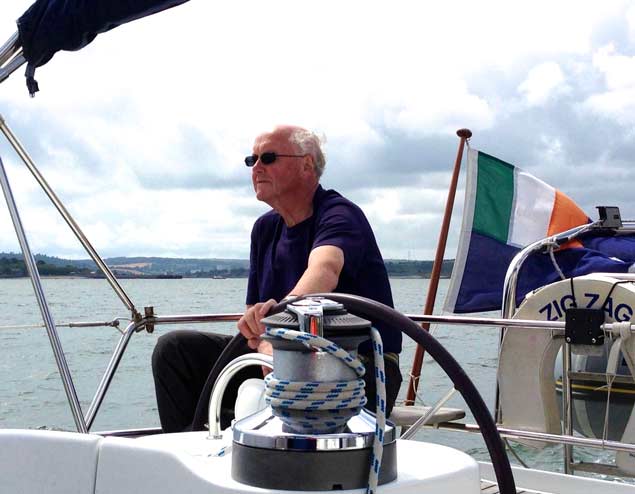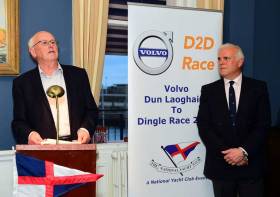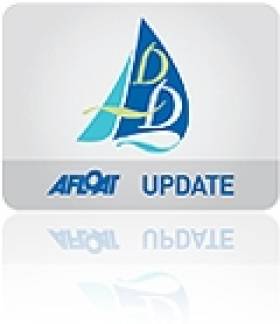Displaying items by tag: Martin Crotty
Martin Crotty 1945-2017
Martin Crotty of the National Yacht Club, one of the great enhancers both of our sport and of life itself, has been taken from among us all too soon, and the thoughts of the Irish sailing community – and a broader community beyond it at home and abroad – are very much with his family, his many friends and his clubmates in a sad loss in which we all share.
He started sailing at an early age, and became a stalwart of the Dun Laoghaire Flying Fifteen class in partnership with Jim Gorman, father of current Flying Fifteen pace-setter David Gorman. But Martin’s intellectual curiosity, and interest in a more complex form of sailing with a broader scope, then led to a partnership with Peter Cullen in the Everitt-designed Half Tonner Eliminator, which they campaigned very actively with increasing success.
By going into the Eliminator partnership, Martin began a dynamic boat-owning linkup with Peter Cullen which was to last the entire 38 years until his death on Saturday. Peter Cullen and Martin Crotty were much more than just a boat-owning duo – they were close friends, they complemented each other, their different abilities and personality traits were mutually beneficial, and they fairly crackled with ideas for the development and improvement of sailing.
Their partnership progressed through three more boats – the David Thomas-designed Bolero 35 Nyala (“rather over-canvased, but great sport and unbeatable in her special conditions”), and then another but very different David Thomas design, the hefty yet speedy Sigma 41 Koala which they campaigned and cruised from 1991 to 1999 through nine very active seasons, with thousands of miles logged.
They then “settled down a bit” with the handsome dark blue Beneteau 50 Zig Zag, which in fifteen and more seasons has cruised extensively to many parts of Ireland, but France and Spain – particularly northwest Spain – have also been much favoured. A couple of years ago, to mark Martin’s 70th birthday, he and Peter made what was to become their last extensive cruise together, out to northwest Spain and back again, two crossings of the Bay of Biscay.
 Quietly happy aboard his boat – Martin Crotty at the helm of Zig Zag. Photo: Peter Cullen
Quietly happy aboard his boat – Martin Crotty at the helm of Zig Zag. Photo: Peter Cullen
Ashore, Martin was a surprisingly private person for one who played so many key roles across a wide range of interests, some of them highly visible. He was actually qualified as a barrister, yet never practised, for despite his never-failing politeness and tendency to be a backroom operator, he was fascinated by the world of corporate business, and achieved notable success and fulfillment in his career in Corporate Design.
As for his input into sailing, his best-known innovation was the introduction, with the full backing of Peter Cullen, of the biennial Dun Laoghaire to Dingle Race in 1993. This really was totally new. Many people had thought of a non-stop Round Ireland Race long before Wicklow Sailing Club finally bit the bullet with total dedication in 1980. But absolutely no-one had thought of anything like a 280-mile race from the stately harbour of Dun Laoghaire in all its style on Dublin Bay, all the way to one of the most westerly fishing ports in Ireland, a place so redolent of the majesty of the Atlantic seaboard that it could have been on a different Continent. Yet thanks to the Crotty-Cullen initiative, the two very different ports were brought together and have maintained this unique, wonderful and growing seafaring and sporting bond ever since.
However, even an event as strong as this suffered from some numbers depletion during the Economic Recession. But although he had been running it for more than 15 dedicated years, Martin was determined to see the D2D back to full health before finally handing it over. In the Spring of 2017, with entries for the up-coming race in June already at record levels, he finally made the full administation handover to Adam Winkelmann, whom he had recruited to shadow his staging of the race in 2013, when signs of recovery were already beginning to become evident.
But although the hugely popular Dun Laoghaire to Dingle Race is Martin Crotty’s most tangible legacy in Irish sailing, he should be remembered for much else. He was himself an excellent sailor, with that perfect combination of courage, ability and good sense which provides the perfect shipmate. He was fascinated by traditional navigation – he was a skilled hand with the classic sextant – yet he was equally adept with the most modern technology, and as Peter Cullen puts it, “There was no better man to have around when the electronics were acting up – he was better than many professionals”.
Another aspect of his wide-ranging personality was an encyclopaedic knowledge of flag etiquette. Quite how he managed to find the brain space for this arcane subject in his already well-furnished mind is a matter of wonder, yet the way of thinking which this indicates made him a formidable committee man, and he rose through the ranks to become Vice Commodore of his beloved National YC.
It was his final role with the NYC which perhaps best defined Martin Crotty. Upwards of three years ago he was appointed a Trustee of the Club. Some club Trustees are sometimes no more than names at the top of headed notepaper. But at a difficult time for yacht club life throughout Ireland as we struggled out of recession, Martin Corry was a Trustee that the Commodore and every committee in the National Yacht Club knew they could readily call on for the most sage and useful advice for each and every difficult decision.
Speaking today in fond remembrance of his friend Martin Crotty, National Yacht Club Commodore Ronan Beirne remembered his many services to sailing, but he spoke in particular of his solid reliability in his final role as a Trustee: “He was our rock. He would be completely measured, sound and considered in his deliberations, and his advice would be proven right. We will miss him for so many things. And we will miss him for his excellent company.”
WMN
Dun Laoghaire to Dingle Race 2011 is Launched
The possibility of an Open 40 entry plus a new white sail division are just some of the developments for the tenth Dingle Skellig Hotel Dun Laoghaire to Dingle Race. Over 50 (SCROLL DOWN FOR PHOTOS BY MICHAEL CHESTER) gathered at the National YC in Dun Laoghaire last night to hear local TD and the Minister for Sport, Tourism and Culture Mary Hanafin give a ringing endorsement for the unique 320-mile offshore race when it sets sail on June 11th. A notice of race and entry form is available for download below.
The last race attracted 39 entries and a course record was set by Michael Cotter's Whisper. This year organisers Martin Crotty and Brian Barry along with Dingle Harbour master Brian Farrell are confident that they will break the 40 boat barrier. They may well be right as the event has been specifically timed to bring Dublin boats to the south coast for ten days of racing at the ICRA Nationals in Cork Harbour and the Sovereigns Cup the following week in Kinsale.
The event is also benefitting from inclusion in this year's ISORA calendar.
Present last night were represntatives from the major Bay clubs, including Breda Dillon from Howth YC and Fintan Cains of ICRA. Peter Ryan of ISORA, who is also the National YC commodore spoke about plans to develop off shore sailing and the club's plans to welcome the international Figaro offshore fleet in August.
Solo sailor Mick Lidddy who is making a bid for an Irish entry into the race was also in attendance.
SCROLL DOWN FOR LAUNCH PHOTOS BY MICHAEL CHESTER
Afloat coverage of the 2009 Race is HERE






























































